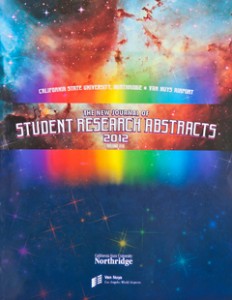Cal State Northridge Publication Highlights Research by Young Scientists
 For nearly a year, hundreds of local K-12 students toiled tirelessly, testing theories and hypotheses. They pondered such questions as whether mice really do prefer cheese or if dairy products have an effect on singing.
For nearly a year, hundreds of local K-12 students toiled tirelessly, testing theories and hypotheses. They pondered such questions as whether mice really do prefer cheese or if dairy products have an effect on singing.
The results of these and dozens of other experiments were published in the 17th volume of California State University, Northridge’s “The New Journal of Student Research Abstracts,” which was released late last semester.
Founded by Northridge biology professor Steven Oppenheimer, the journal aims to highlight significant work conducted by local young scientific researchers and the teachers who assist them throughout the process. It is published annually by CSUN and the Van Nuys Airport, and features research by students from schools from throughout the San Fernando Valley.
“The journal showcases the research of young students and excites them about research science,” Oppenheimer said. “This is critical for this nation’s future as national security, health and welfare depend on top U.S. research scientists.”
Through an “open door” model, any K-12 teacher can submit a student abstract to Oppenheimer for review. The abstracts submitted can cover a wide range of topics.
For example, Ashley Maynez and her teacher, S. Tanaka, of Gaspar de Portola Middle School in Tarzana, wanted to know if playing the video game “Guitar Hero III” improved reflexes. They subjected two volunteers through a series of reflex exercises. Following these exercises, the volunteers were asked to play one, four-to-five minute “Guitar Hero” song. The volunteers then repeated the initial reflex exercises. The researchers found that reflexes related to sound were significantly improved.
Christine Montemayor and Nora Lapena of Ernest Lawrence Gifted/Highly Gifted Magnet Middle School in Chatsworth wanted to know the effects of chocolate and dark chocolate on acne. The two, guided by teacher G. Zem, experimented by feeding participants one serving of Hershey’s Kisses—one dark and one regular—in alternate weeks. The students took a photo of the face of each participant. They found that both chocolate types caused acne breakouts; however, dark chocolate caused worse effects than the other.
Oppenheimer said the ultimate goal of the journal is “worldwide enhancement of K-12 science education.”
He noted that the journal is now available online thanks to CSUN ScholarWorks, a digital preservation program accessible to the public. To view the journal online, visit the CSUN ScholarWorks website at http://scholarworks.csun.edu/xmlui/handle/10211.2/1984.
“This is a monumental development for the journal,” said Oppenheimer.
Oppenheimer has received numerous awards for his dedication to science education, including the 2009 U.S. Presidential Award for Excellence in science, mathematics and engineering mentoring.
In a letter published in the latest journal, former high school researcher Drew Edelberg expressed how his participation in the journal granted him “invaluable research experience” that aided in his success at UC Berkeley and now at Columbia University, where he began working on a Ph.D. in solid-state physics in fall 2012.
The next abstract submission deadline is June 1. Submissions can be sent to Oppenheimer at steven.oppenheimer@csun.edu.

 experience
experience